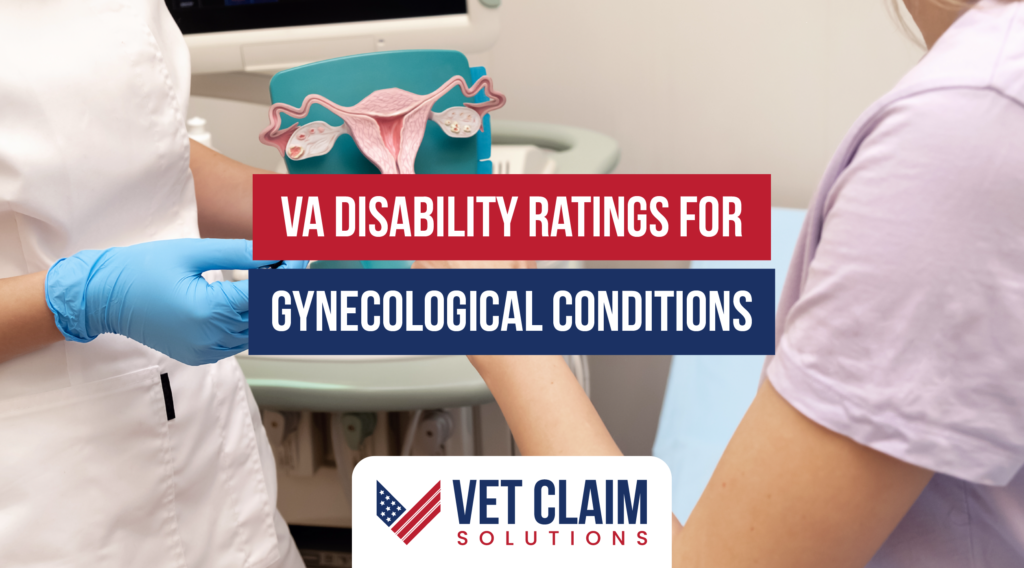Navigating VA Disability Ratings for Gynecological Conditions
Navigating the path to receiving VA disability benefits can feel like charting a course through uncharted waters. This is especially true for women veterans, who face unique challenges when seeking VA Disability Ratings for Gynecological Conditions. But, remember you don’t have to face these challenges alone. Filing for any VA Disability claim can seem like you’re up against an impossible system, and it can feel overwhelming.
I’ve helped so many women veterans just like you, who have served our country honorably, and deserve clear and compassionate guidance when it comes to understanding VA disability ratings for gynecological conditions. I cannot stress enough how important it is to request access to your medical records and seek out a free case evaluation. It can make all the difference in getting the disability benefits you deserve.
Service Connection: Linking Your Gynecological Condition to Your Military Service

First things first, did your gynecological condition start during your military service? Or, did a condition you already have get worse because of your service? This matters because the VA needs to see that your condition is directly related to your service. They call this a service connection, and it is critical you can demonstrate it for your claim.
But service connection isn’t just about showing when it happened, you’ve also got to have the paperwork. The VA looks at things like your medical records, a diagnosis, and what treatment you’ve received. You’re going to want to dig deep into those records to support your claim for VA disability ratings for gynecological conditions. This will help ensure the VA assigns the appropriate disability rating for your specific situation.
What if Your Gynecological Condition Developed After Service?
Let me tell you, the clock doesn’t stop ticking on the effects of service once your time in uniform ends. There are times when a condition develops years down the line due to something that occurred in service. Unfortunately, so many health challenges surface years later.

That’s why it’s so important to understand this critical factor. It can be difficult to connect the dots from a health condition now, to something from long ago during service. That’s where a medical professional who specializes in connecting service with health challenges comes in – their medical opinion can carry a lot of weight in your claim. The medical professional’s evaluation, which should include a thorough review of your medical records, will hinge on whether it’s “at least as likely as not” your gynecological condition traces back to your military service. These connections are crucial if you are seeking to establish service connection for VA disability benefits, and may even qualify you for special monthly compensation.
Understanding VA Disability Ratings for Gynecological Conditions
Okay, you’ve got your service connection, now what? Now, the VA uses its system, outlined in the General Rating Formula for Gynecological Conditions and Disorders of the Breast, to figure out how much disability compensation you’re eligible to receive. This schedule breaks down the ins and outs of how the VA assigns disability ratings for a variety of conditions, and how it impacts your financial support. Their goal is to look at how much your condition affects your daily life. The worse the symptoms, the higher the rating, which can be anywhere from 0% all the way to 100%.

How are VA Disability Ratings Determined?
VA Disability Ratings for Gynecological Conditions hinge on how severe your symptoms are, and importantly – how much those symptoms impact your ability to hold down a job or go about daily life. They will also take into consideration if your symptoms require continuous treatment. The VA offers a free case evaluation, and I highly recommend veterans seeking disability benefits take advantage of this service.
Let me give you an example. Take a look:
| Gynecological Condition | VA Disability Rating | Example Monthly Payment (2024 rates for Veteran Only) |
|---|---|---|
| Symptoms not controlled by treatment | 30% | $524.31 |
| Symptoms that require continuous treatment | 10% | $171.23 |
| Symptoms that do not require continuous treatment | 0% | $0 (May still qualify for certain benefits.) |
I want you to know that even a 0% rating can make you eligible for important benefits, like access to VA Healthcare. You may still be able to receive crucial services. I cannot stress that enough – always apply if you have a condition that is affecting you. There’s no harm in it.
Can Secondary Service Connections Impact VA Disability Ratings for Gynecological Conditions?
One of the things a lot of people miss, including some medical professionals, is that a primary condition often opens the door to a secondary condition. A primary service-connected condition can absolutely be linked to secondary conditions you may be experiencing. Think of it this way: let’s say, as an example – you’re struggling with debilitating migraines that are officially linked to your service. Now, those migraines trigger intense anxiety for you – this could be a secondary service connection, and you may be able to claim disability for that as well.
It’s also really important to realize that you’re eligible to apply for multiple conditions stemming from your time in service, this isn’t a “pick one only” type of deal. When thinking of secondary conditions and VA Disability Ratings for Gynecological Conditions, Polycystic Ovary Syndrome (PCOS) can be an example of this.

More than half of all women with PCOS also struggle with Type 2 Diabetes. Did you also know that women struggling with PCOS are also 40% more likely to have high blood pressure? Conditions like sleep apnea, post-traumatic stress disorder (PTSD), and irregular periods are also common in women veterans. PCOS can make it harder to maintain a healthy weight, and it can impact your mental health.
Let’s be honest, no one can rewind time and prevent what you faced in the line of duty. This is where secondary conditions, linked to those initial experiences, enter the picture. It’s also important to be aware that you may qualify for TDIU benefits if your gynecological conditions, whether primary or secondary, prevent you from maintaining substantial gainful employment.
Important Considerations When Filing for VA Disability for Gynecological Conditions
Believe me, I get how deeply personal these gynecological challenges can be, and no one likes talking about them, let alone sharing those struggles with strangers. You might think your condition isn’t “serious” enough – but that shouldn’t keep you from seeking help. Remember, a 0% rating can still get you access to healthcare and support.
Always remember, never give up. You served our country. The VA Disability process may seem impossible to navigate, but there are resources out there to help. Stay the course. Your courage and sacrifice earned it.
Conclusion
Navigating VA disability ratings for gynecological conditions doesn’t have to be overwhelming. The key is getting started. Knowledge is empowering. By arming yourself with the right information and resources, such as understanding common gynecological conditions and the necessary diagnostic codes, you can face this challenge head-on.
FAQs about VA Disability Ratings for Gynecological Conditions
FAQ 1: What is the VA rating for menstrual disorders?
The VA rating for menstrual disorders can vary greatly depending on the specific diagnosis and the severity of your symptoms. It’s essential to have your condition properly diagnosed and documented. With menstrual disorders, your rating will be based on the General Rating Formula for Gynecological Conditions found in 38 CFR § 4.116, which considers the severity and impact on your daily life. A higher rating, meaning a higher disability percentage, usually corresponds to more frequent and severe symptoms that interfere with your ability to work or engage in everyday activities. Always consult with a medical professional specializing in gynecological health to accurately determine the potential VA rating for your specific situation.
FAQ 2: Is an abnormal Pap smear a VA disability?

Unfortunately, an abnormal Pap smear is not by itself a qualifying factor for VA disability. This is because it is generally considered a screening tool for cervical cancer rather than a disability itself. To receive VA disability for a gynecological condition related to an abnormal pap smear, you must demonstrate a service-connected condition that caused it. This often means linking your abnormal pap smear result to another qualifying gynecological condition and proving that it either began during your military service or was aggravated by your time in service.
FAQ 3: What is the VA rating for cervical conditions?
Similar to other gynecological conditions, there isn’t a one-size-fits-all answer because each situation is assessed based on its individual circumstances. You can receive a VA Disability rating for cervical conditions if they originated during your time in service, or were made worse by it. Factors like whether you need surgery, have ongoing pain, or have difficulty with fertility will come into play when determining your disability rating for a service-connected cervical condition.
FAQ 4: What is the VA disability rating for a total hysterectomy?

When it comes to VA Disability ratings for Gynecological Conditions, a total hysterectomy can be a life-altering event. The VA assigns a 100% rating for a total hysterectomy for the first three months following the surgery. This means your rating after those three months could be either 30% if both ovaries were removed, or one ovary was removed and the remaining ovary is not functioning, or a 0% rating after those first three months if one ovary is still intact and working.


